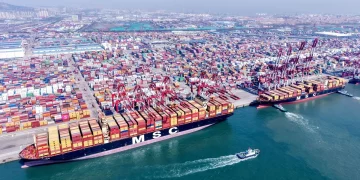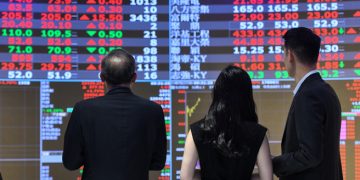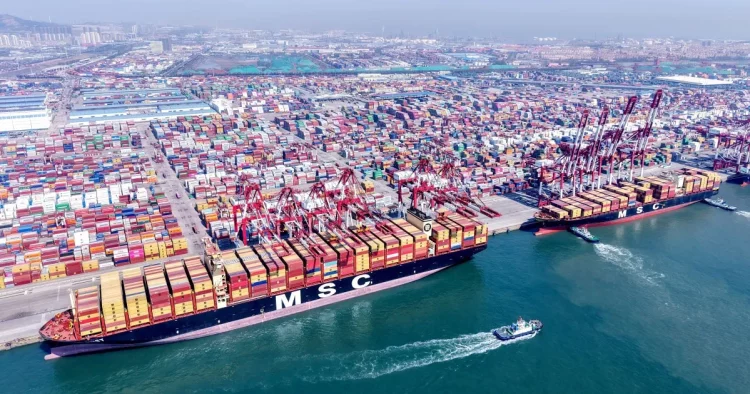China has long been a major engine of global growth. Its rapid industrialization and expansion over the past few decades have significantly reshaped global trade, investment flows, and commodity prices. However, recent economic indicators signal that China’s economy is slowing down, and the implications for global growth are profound. This article examines the slowdown in China’s economy, key indicators driving this shift, and how it will affect global markets. Additionally, we will explore the opportunities and risks for investors navigating this uncertain terrain.
Introduction: China’s Slowing Growth and Its Impact on the Global Economy
China’s rapid economic growth has been a key driver of global expansion for more than a generation. As the world’s second-largest economy, China’s consumer base, manufacturing power, and role as a global trade hub have shaped the contours of international economic relations. From the early days of its market liberalization in the late 20th century to its emergence as a dominant player in the global supply chain, China’s growth has been unparalleled.
However, China’s growth has begun to slow in recent years, and this deceleration has raised concerns about its impact on the global economy. China’s economic transformation from an export-led growth model to one driven more by domestic consumption and services has encountered numerous challenges. Structural issues such as an aging population, increasing debt levels, and a crackdown on certain industries have added to the pressure. The COVID-19 pandemic further exacerbated these challenges, stalling China’s recovery and revealing vulnerabilities in its economic structure.
As China’s economy slows, the global ramifications are inevitable. The international community is closely watching how China’s reduced growth rate will affect global demand for goods, commodities, and services. The ripple effects are being felt across various sectors, from technology to energy. With China being a major player in global trade and finance, a slowdown in its growth inevitably raises questions about the future trajectory of the global economy.
Key Indicators: Economic Data Revealing the Slowdown and Implications for Global Trade
Several key economic indicators signal China’s slowing growth and help shed light on its potential impact on global trade. These include GDP growth rates, industrial production data, retail sales, export and import trends, and more.
Slower GDP Growth
For decades, China’s GDP growth averaged around 10%, but recent years have shown a significant decline. According to official data, China’s GDP growth rate for 2023 was just 4.5%, well below the government’s target and a dramatic fall from previous growth figures. This slower growth is indicative of broader structural challenges within China’s economy, including a reduced pace of industrial expansion, declining productivity growth, and demographic shifts that are impeding the country’s economic potential.
While China’s official GDP data has been the subject of some debate, the trend of decelerating growth is undeniable. With lower-than-expected growth rates, China’s economic engine has slowed, and this will undoubtedly affect global trade flows. Lower growth means reduced demand for raw materials, finished goods, and energy, which directly impacts the global supply chain.
Declining Industrial Production
Industrial production is another key indicator showing China’s economic slowdown. China has long been the world’s manufacturing powerhouse, but recent reports show a slowdown in industrial output. Factors such as overcapacity in certain sectors, regulatory crackdowns on industries like real estate, and the ongoing effects of the pandemic have all contributed to reduced industrial production. The decline in China’s manufacturing output is especially critical for global supply chains, as China has long served as a source of low-cost manufacturing for goods ranging from electronics to textiles.
As industrial output declines, it also signals reduced demand for industrial commodities such as steel, copper, and aluminum. This reduction in demand will likely impact global commodity prices, especially in emerging markets that rely heavily on Chinese consumption of raw materials.
Weak Retail Sales and Consumer Spending
Another key factor contributing to China’s slowdown is weaker domestic consumption. Retail sales data has shown that consumer spending is not rebounding as expected. While the government has implemented stimulus measures, consumer confidence remains low, especially among younger generations who are dealing with high levels of debt and uncertain job prospects. The slowdown in consumer spending in China is also a key indicator of broader economic malaise, which affects everything from luxury goods to basic consumer products.
This decline in domestic consumption in China has global ramifications. As one of the world’s largest consumer markets, China’s slowdown in consumer spending translates into reduced demand for foreign goods and services. Multinational companies with significant exposure to China, such as those in the luxury goods, automotive, and technology sectors, are likely to feel the impact as consumer sentiment weakens.
Declining Exports and Imports
China’s role as both a major exporter and importer has made its slowdown particularly significant for global trade. On the export side, Chinese manufacturers have been struggling with reduced demand for their products due to weaker global economic conditions. The trade war with the United States, along with supply chain disruptions caused by the pandemic, has resulted in decreased exports, particularly in key sectors like electronics, machinery, and textiles.
On the import side, China has been importing fewer raw materials and consumer goods as its industrial production slows and domestic consumption weakens. This drop in imports will likely affect economies that rely on exporting commodities to China, particularly in Latin America, Africa, and parts of Asia.

Impact on Global Markets: What Sectors Will Be Most Affected, Including Commodities and Technology
The slowdown in China’s economy will have far-reaching effects on various global markets, with certain sectors feeling the impact more acutely than others.
Commodities: A Decrease in Demand
China’s reduced industrial activity will lead to decreased demand for many commodities that are essential to its manufacturing sector. The most affected commodities will likely include oil, steel, copper, and other industrial metals. China’s demand for crude oil, for example, has been a major factor in global oil prices. As China’s economy decelerates, its demand for energy will decrease, putting downward pressure on global oil prices and other commodities.
Emerging market economies that are highly dependent on exports to China, particularly in Latin America, Africa, and Southeast Asia, will feel the brunt of this decline in commodity prices. Countries like Brazil, South Africa, and Chile, which export key raw materials to China, will face reduced revenues from these exports. This will likely result in slower economic growth and potentially higher fiscal deficits in these countries.
Technology: A Mixed Outlook
The technology sector is another area that will see both challenges and opportunities as a result of China’s slowdown. On one hand, China’s reduced demand for consumer electronics, gadgets, and hardware will have a negative impact on global tech companies that rely heavily on China as both a manufacturing base and a market. Companies like Apple, Samsung, and various semiconductor manufacturers are highly exposed to Chinese demand, and a slowdown in China’s consumer spending will hurt sales in these sectors.
On the other hand, China’s focus on developing its domestic tech sector, particularly in areas such as artificial intelligence, 5G, and semiconductors, presents new opportunities for technology firms. While Chinese firms face growing restrictions from Western markets, they are focusing on self-reliance in tech development, creating new avenues for global tech firms that specialize in these areas.
Global Financial Markets: Investor Caution
China’s economic slowdown has already begun to weigh on global financial markets. Equity markets in both developed and emerging economies have seen increased volatility as investors adjust their expectations for global growth. The Chinese stock market has been particularly vulnerable to domestic economic uncertainties, and foreign investors have become increasingly cautious about placing bets on Chinese equities. This cautious sentiment has spread to global markets, with investors reevaluating their portfolios in light of the potential knock-on effects of China’s slowdown.
The currency markets are also impacted. The Chinese yuan has depreciated against the US dollar and other major currencies, reflecting growing concerns about China’s economic outlook. A weaker yuan could exacerbate inflationary pressures in global markets, particularly in countries that rely heavily on Chinese imports.
Opportunities and Risks: How Investors Can Navigate This Uncertain Terrain
Investors will need to navigate the complexities of China’s economic slowdown with caution. While the risks are apparent, there are also opportunities in this changing global landscape.
Opportunities for Diversification
One of the key strategies for investors will be diversification. As China’s growth slows, emerging markets that are less reliant on Chinese demand may become more attractive. Countries in Southeast Asia, India, and parts of Africa may offer new growth opportunities as their economies continue to develop independently of China. Investors should consider rebalancing their portfolios to reduce exposure to China and increase exposure to other fast-growing regions.
Opportunities in Sustainable Industries
China’s slowdown could also accelerate the global shift toward more sustainable industries. As the country faces environmental challenges and an aging population, there will likely be increased government and corporate investment in renewable energy, electric vehicles, and other green technologies. Investors who focus on these sectors may find growth opportunities, especially in companies that are positioned to capitalize on China’s transition to a more sustainable economy.
Risks in Commodity-Dependent Markets
The primary risk for investors will be in commodity-dependent markets. As demand for commodities such as oil, steel, and copper decreases due to China’s slowdown, commodity prices may remain under pressure. Investors with heavy exposure to commodity-related assets should reassess their positions and consider diversifying into other sectors that are less susceptible to China’s economic fluctuations.
Currency Risks
The depreciation of the Chinese yuan may create risks for investors with significant exposure to China. While a weaker yuan could benefit Chinese exports, it could also lead to inflationary pressures in other economies and undermine investor confidence in Chinese assets. Investors will need to carefully monitor currency fluctuations and adjust their strategies accordingly.
Conclusion
China’s economic slowdown presents a challenging environment for global growth, with significant implications for international trade, commodities, and financial markets. While the slowdown is likely to affect sectors such as commodities and technology, there are also opportunities for investors who are willing to adapt and diversify. The key to navigating this uncertain terrain will be staying informed about the evolving economic situation in China and taking proactive steps to hedge risks and capitalize on emerging growth areas. By understanding the dynamics of China’s slowdown and its ripple effects across global markets, investors can better position themselves to thrive in a changing world.
































